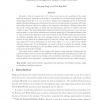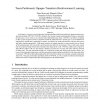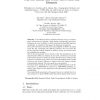978 search results - page 107 / 196 » Knowledge, Probability, and Adversaries |
PDCAT
2005
Springer
15 years 3 months ago
2005
Springer
Recently a bulk of research [14, 5, 15, 9] has been done on the modelling of the smallworld phenomenon, which has been shown to be pervasive in social and nature networks, and eng...
WS
2004
ACM
15 years 3 months ago
2004
ACM
In many applications of wireless sensor networks (WSN), sensors are deployed un-tethered in hostile environments. For locationaware WSN applications, it is essential to ensure tha...
AGENTS
1999
Springer
15 years 2 months ago
1999
Springer
In this paper, we present a novel multi-agent learning paradigm called team-partitioned, opaque-transition reinforcement learning (TPOT-RL). TPOT-RL introduces the concept of usin...
SP
2010
IEEE
15 years 1 months ago
2010
IEEE
Abstract—Belief and vulnerability have been proposed recently to quantify information flow in security systems. Both concepts stand as alternatives to the traditional approaches...
CHES
2006
Springer
15 years 1 months ago
2006
Springer
It is well known that a malicious adversary can try to retrieve secret information by inducing a fault during cryptographic operations. Following the work of Seifert on fault induc...



